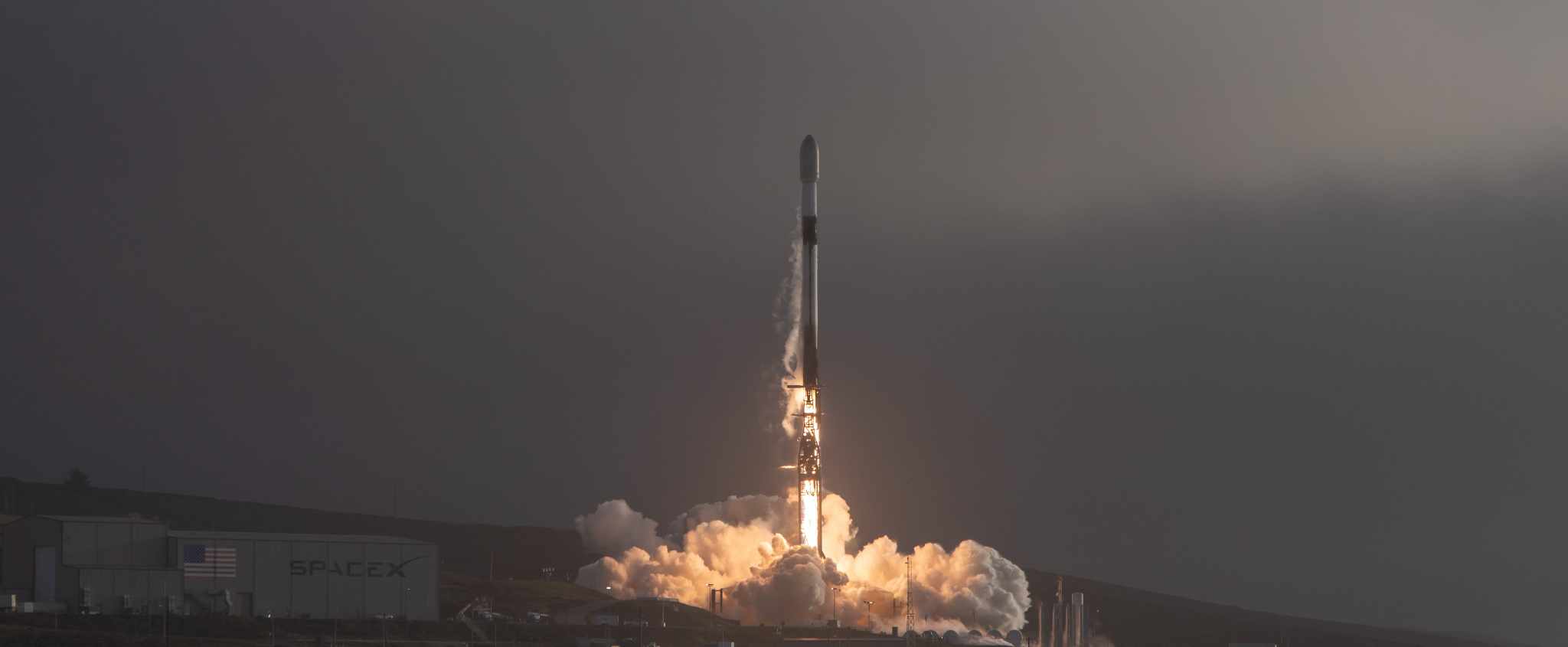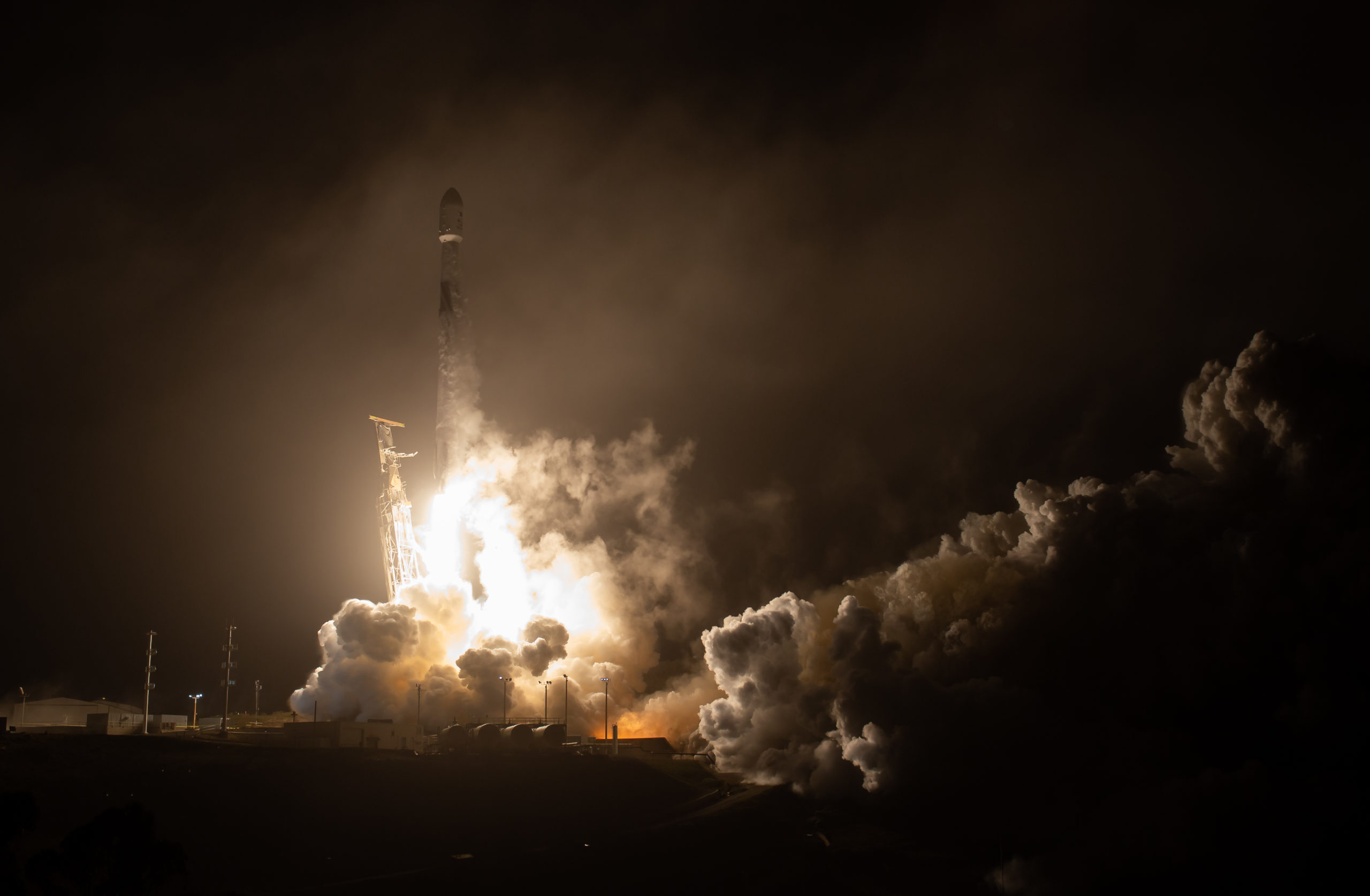
Following five consecutive nights of delay, SpaceX has successfully conducted its seventh Falcon 9 mission inside January’s third week and its third of the month out of Vandenberg Space Force Base, Calif., when its most-used West Coast booster took flight at 4:35 p.m. PST Tuesday. The seasoned B1063 booster—a grizzled Vandenberg veteran, flying a record-breaking 15th time from the West Coast and the 16th mission of its career so far—rose from Space Launch Complex (SLC)-4E into glorious late-afternoon skies and 80-percent weather favorability to deliver the year’s fifth batch of Starlink internet communications satellites into low-Earth orbit.

A year ago, seven launches across the span of an entire calendar month was a newly achieved personal best for SpaceX, with the Hawthorne, Calif.-headquartered organization scoring its first eight-launch month last March and its first month to feature nine launches last August. Each consecutive month since then has also seen nine launches, but despite 2023’s record-breaking cadence of 96 Falcon 9 and Falcon Heavy missions SpaceX is reportedly aiming for around 144 launches this year, an average of 12 per month.
January began with impressive pace, as a pair of Falcon 9s roared aloft from opposing seaboards of the United States—a Starlink launch from Vandenberg and Sweden’s Ovzon-3 broadband communications satellite from Cape Canaveral Space Force Station, Fla.—conducted only 19 hours and 20 minutes apart on the year’s third day. But the pace stalled a little in January’s second week, when the second Vandenberg mission of the year suffered several days of delay due to poor weather on the West Coast, and both last Thursday’s Ax-3 launch and tonight’s Vandenberg mission endured delays of their own.

However, averaging a flight every 3.5 days so far in January is broadly in line of where SpaceX needs to be in order to be hitting 12 launches per month. Last year’s 96-flight year achieved a mission every 3.8 days, which allows a back-of-the-envelope extrapolation that—based upon the cadence seen so far in 2024—there could be at least 135 missions flown before the next New Year’s Eve bell tolls.
Last year’s movement from seven to eight and later to a regular pattern of nine monthly launches between December 2022 and August 2023 leaves little reason to doubt that SpaceX’s ability to execute a rapid-fire manifest will continue to grow. And that should make Elon Musk’s oft-stated goal of 144 missions this year—a launch every 2.5 days or so—reasonably achievable.

Flying last night’s mission was B1063, which entered service in November 2020 and went on to log five launches in 2022 and a further seven in 2023. Key payloads have included NASA’s Sentinel-6 Michael Freilich and Double Asteroid Redirection Test (DART), the second Tranche 0 batch of Transport and Tracking Layer (TTL) satellites for the Space Development Agency (SDA), five Iridium NEXT global mobile communications satellites, 16 advanced broadband satellites for London, England-based OneWeb, 472 Starlinks and last April’s 51-payload Transporter-7 “rideshare” mission.
Of those launches, all but one occurred from Vandenberg, making B1063 the West Coast’s incumbent fleet-leader. And 2024 looks set to be a banner year for the mountain-ringed launch site, as the Falcon 9 flight rate grew from a single launch in 2013 and 2016 to six missions in 2018, a figure which more than doubled to 13 in 2022 before more than doubling again to no less than 28 by the end of last year.

SpaceX initially targeted Thursday evening during a two-hour “window”, opening at 8:04 p.m. PST and closing at 10:05 p.m. PST, despite a 20-percent possibility of rain showers. In readiness for the flight, the Autonomous Spaceport Drone Ship (ASDS), “Of Course I Still Love You”, put to sea out of Port of Long Beach last week, to prepare for her third Falcon 9 “catch” in the North Pacific Ocean in under three weeks.
Loading of the 230-foot-tall (70-meter) Falcon 9 with liquid oxygen and a highly refined form of rocket-grade kerosene (known as “RP-1”) got underway on time at T-35 minutes. But despite tweeting that “all systems and weather” were go, teams ultimately elected to stand down from Thursday’s launch attempt and enter a 24-hour recycle.

Yet Friday’s expansive window, which included a raft of T-0 points from 6:15 p.m. PST through 9:58 p.m. PST, proved not to be SpaceX’s day either. Propellant loading of the booster got underway a second time, but with all systems declared go, the watchword proved to be the weather and by 6:40 p.m. PST teams again stood down for the second night. Attempts on Saturday and Sunday were also stood down due to the weather.
Tuesday’s try proved charmed, however, and B1063 sprang from SLC-4E and into the gathering gloom of a Vandenberg evening at 4:35 p.m. PST, powering uphill for 2.5 minutes under the combined thrust of 1.5 million pounds (680,000 kilograms) from her nine Merlin 1D+ engines. She then executed a separation maneuver and returned smoothly to alight on OCISLY’s deck a little past eight minutes after launch, to wrap up her 16th career mission and her record-setting 15th out of the West Coast.

Meanwhile, the Falcon 9’s second stage executed a six-minute burn of its single Merlin 1D+ Vacuum engine to deliver the 22 Starlink satellites—totaling 38,800 pounds (17,600 kilograms)—into low-Earth orbit. Deployment occurred at 62 minutes into the flight.
So far this year, five Falcon 9 missions from the East and West Coasts have emplaced more than 100 Starlinks into low-Earth orbit, including SpaceX’s first six “Direct-to-Cell” satellites which permit mobile network providers to offer “seamless global access to texting, calling and browsing”, whether “on land, lakes or coastal waters”, without changing hardware or firmware. Earlier this month, SpaceX teams sent and received their first text messages via Direct-to-Cell a mere six days after launch.

As a network, Starlink enables high-speed and low-latency internet provision to 70 sovereign nations and international markets in North and South America, Europe, Asia, Oceania and Africa. Landlocked Eswatini—formerly Swaziland—in southern Africa, together with Honduras and Paraguay joined Starlink last month.

The downsized Starlink “V2 Mini” satellites, first flown last February, boast three to four times greater “usable” bandwidth than earlier Starlink iterations. “V2 Minis include key technologies—such as more powerful phased-array antennas and the use of E-Band for backhaul—which will allow Starlink to provide 4x more capacity per satellite than earlier iterations,” SpaceX explained. “Among other enhancements, V2 Minis are equipped with new argon Hall thrusters for on-orbit maneuvering.”
Florida-based intercity operator Brightline adopted Starlink on its trains earlier in 2023, the first passenger rail service in the world to do so. Additionally, El Salvador’s Ministry of Education has begun integrating Starlink capability into its schools to help close the digital divide between urban and remote rural communities and 50 Rwandan schools are now connected via Starlink’s high-speed internet service.





